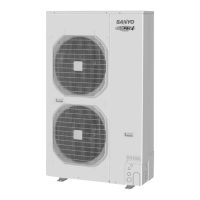8
●
When using a receiver that has been installed separately into the ceiling,use the
enclosed
fittings
for installing to a ceiling.
(1) Remove the metal plate of the receiver by slipping a flathead screwdriver or the like into the
cutout on the bottom.
(2) Cut out a hole in the ceiling to match the dimensions of the enclosed template. (95 X 51 mm)
(3) Pass the wiring through the enclosed installation metal fitting and put it into the hole. (Fig. 8-20)
(4) Bend parts A and B of the metal fitting so they hold onto the ceiling firmly. (Fig. 8-21)
(5) Connect the
receiver’s
wiring (2 cores) with the wiring from the indoor unit. (Refer to “8-17.
Wiring the Receiver Unit”.) When wiring receivers, be sure to double-check the terminal num-
bers of the indoor unit before connecting them so there are no mistakes in the wiring. (Damage
will occur if high voltage [e.g. supply voltage] is applied.)
(6) Adjust the enclosed spacers so they are several millimeters thicker than the ceiling material
and hold the receiver in place temporarily with the 2 enclosed machine screws. (M4 X 40)
(7) Bend parts A and B back so they fit in the opening and are in the gap between the surface of
the ceiling and the receiver; then tighten the screws. Do not use too much force when tighten-
ing the screws. Doing so may warp or damage the case. Move the receiver by hand and check
that it can move just a little. (Fig. 8-22)
(8) Attach the face plate.
Fig. 8-20
-+
-+
Fig. 8-21
Part A
Part B
Fig. 8-22
8-17. Wiring the Receiver Unit
●
Use wiring of 0.5 mm
2
to 2 mm
2
for field supply.
●
Use a total wire length of no more than 400 m.
Polarity does not matter.
If it is to be used as an embedded model;
Enclosed wire joints (2, white)
Terminal strip for wiring the
remote control of the indoor
unit
Connections
Receiver wires
(Field supply)
Wires from the
receiver unit
Receiver
White
Black
1
2
1
2
●
Wiring Diagram
1. Strip the wire to be connected of its sheathing for 14 mm.
2. Twist the two wires together and crimp the enclosed wire joint.
3. If a special crimping tool is not used, or if the connection is made using solder,
wrap the joint with insulating tape.
Receiver wires
(Field supply)
Wire joint CE-1 (Enclosed)
Receiver wires
(Field supply)
If it is to be used as an exposed model:
1
2
1
2
Receive
Terminal strip for wiring
the remote control of the
indoor unit
Remote Control Cord
(Sold Separately)
White
Black
●
Wiring Diagram
●
Use remote control cord (sold separately) for wiring a separately installed receiver.
(1) For instructions on how to install a remote control cord (sold separately), refer to the chapter on Using as an
Embedded Model in Installing Separate Receivers.
(2) If a remote control cord (sold separately) is to be used, refer to the Mounting Instructions attached to the remote
control cord.
NOTE
1. When wiring remote controls, be sure to double-check the terminal numbers of the indoor unit connecting them
so there are no mistakes in the wiring. (Damage will occur if high voltage [e.g. supply voltage] is applied.)
2. If the wiring to the operation panel is bundled together with other wiring, such as the incoming line from the
power source, it can cause a malfunction, so avoid doing so.
3. If something causes the unit
’s
power source to make noise it will be necessary to resolve the problem, such as
by installing a noise filter.
8-10
SM830161Book.indb10SM830161Book.indb10 2008/05/279:11:352008/05/279:11:35

